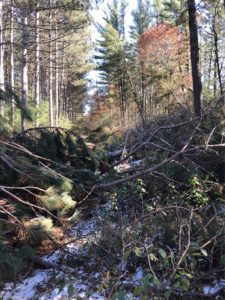 Does your community need assistance with a substantial parcel of natural woodland (more than 10 acres) under municipal jurisdiction? If so, contact your local DNR Urban Forestry Coordinator. He or she can help you find the expertise you need by connecting you with the appropriate DNR professionals.
Does your community need assistance with a substantial parcel of natural woodland (more than 10 acres) under municipal jurisdiction? If so, contact your local DNR Urban Forestry Coordinator. He or she can help you find the expertise you need by connecting you with the appropriate DNR professionals.
Don Kissinger, North Central Regional Urban Forestry Coordinator, recently provided this type of assistance on two separate occasions (described in detail below). Through his contacts at the Wisconsin Rapids DNR Field Forestry Team, Don was able to help a municipality plan for the impact of the emerald ash borer (EAB) in a large community park. Shortly afterwards, he again called upon DNR Field Forestry, this time to assist a technical college with storm damage in its school forest.
Mark Ryskiewicz, Marshfield City Forester, had been successfully dealing with EAB on the city’s boulevards, but the situation in 33-acre Braem Park required a different type of expertise. Approximately 20 acres of the park are comprised of natural woodland containing a significant number of ash trees. A portion of the stand encompasses a disc golf course. Mark contacted Don who connected with the Wisconsin Rapids DNR Field Forestry Team, and Forester Gavin Hutchinson was called upon to assist. A resulting cruise of the stand provided information relating to condition and a volume estimate of ash. The city of Marshfield, which is currently revising the master plan for Braem Park, can use this data to determine the next best steps for the park.
Deb Crunkilton, Urban Forestry Instructor at Mid-State Technical College, Wisconsin Rapids Campus, was seeking advice on how to manage a small wooded area that was damaged by storms in July 2019. This “blowdown” occurred at a registered school forest that participates in the Wisconsin Community Forestry Program, a collaboration between the DNR and UW-Stevens Point. Deb contacted Don for assistance, who again solicited assistance from Gavin. After visiting the site and discovering large amounts of red pine pocket decline and invasive buckthorn, Gavin was able to provide several options. These options run the gamut of clear cutting the area with the potential for a future chemical treatment of the buckthorn and seedling planting, to allowing the stand to its own future devises. The decision is up to Mid-State, but now they have more well-defined options and a professional contact to provide insights.
To learn more about the Wisconsin Community Forest Program, contact Gretchen Marshall with the LEAF Program at UWSP: (715) 346-2633, email: Gretchen.Marshall@uwsp.edu.
If you would like to get in touch with your local Urban Forestry Coordinator, please visit this website for contact information.
